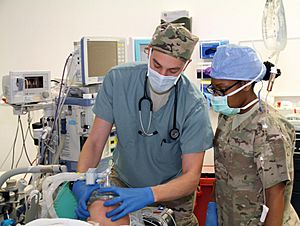Anesthesiology facts for kids

An anesthesiologist controlling a patient's airway while inducing anesthesia
|
|
| Focus | Anesthesia, perioperative medicine |
|---|---|
| Subdivisions | Intensive care medicine Pain medicine Critical emergency medicine |
| Specialist | Anesthesiologist Anaesthesiologist Anaesthetist |
| Occupation | |
|---|---|
|
Occupation type
|
Specialty |
|
Activity sectors
|
Medicine |
| Description | |
|
Education required
|
|
|
Fields of
employment |
Hospitals, Clinics |
Anesthesiology (say: an-ess-thee-zee-OL-uh-jee) is a special part of medicine. It focuses on taking care of patients before, during, and after surgery. The main goal is to make sure patients don't feel pain or stress during medical procedures.
Doctors who specialize in anesthesiology are called anesthesiologists or anaesthetists. They do much more than just give medicine to make you sleep. They also manage pain, help in emergencies, and care for very sick patients in the hospital's intensive care unit. Anesthesiologists are often the largest group of doctors in hospitals. They play a key role in making surgery safe and comfortable.
Contents
A Brief History of Anesthesia
For a very long time, people tried to find ways to stop pain during surgery. Ancient civilizations used things like herbs, alcohol, or even acupuncture. But these methods didn't always work well.
The Discovery of Ether
A big change happened in the mid-1800s. Doctors began to experiment with new chemicals like chloroform and nitrous oxide. On October 16, 1846, a dentist named Dr. William Morton showed something amazing. At Massachusetts General Hospital, he used a special inhaler to give a patient diethyl ether. This made the patient completely asleep and unable to feel pain during surgery. This day became known as "Ether Day."
How the Word "Anesthesia" Came About
The word Anaesthesia comes from ancient Greek words meaning "not" and "sensation." It was first used to describe how some plants made people feel numb. After Dr. Morton's success, a doctor named Oliver Wendell Holmes Sr. suggested using "anesthesia." This new word described the state of being asleep and not feeling pain during surgery. Before this, people just called it "etherization" because ether was the only known way to do it.
Growing into a Specialty
Over the next 100 years, anesthesiology grew quickly. Scientists found new medicines and better ways to watch patients during surgery. In the 20th century, doctors learned to use medicines that could temporarily paralyze muscles. This allowed them to help patients breathe with machines. This led to the development of intensive care medicine, which is closely linked to anesthesiology in many places.
In the past, anesthesiologists mainly helped during surgery by giving medicine to make people go into a deep sleep, like a temporary coma. This stopped them from feeling pain or remembering the surgery. Today, their role is much wider, ensuring patients are safe and comfortable throughout their medical journey.
Images for kids
See also
 In Spanish: Anestesiología y reanimación para niños
In Spanish: Anestesiología y reanimación para niños




